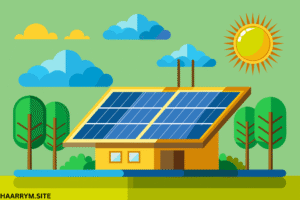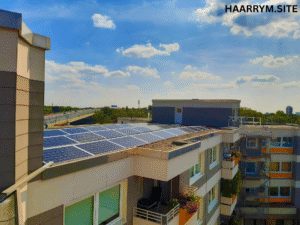Solar energy is leading the way as a clean and reasonably priced alternative in the modern world where sustainability and energy independence are more vital than ever. The solar power grid tie inverter is one of the key parts of any solar energy system as it guarantees that your solar panels may efficiently provide electricity to your house or company while maintaining link to the utility grid.
Including how they operate, their benefits, installation advice, pricing, and more, this thorough article will bring you through everything you need to know about solar power grid connect inverters.
What Is a Solar Power Grid Tie Inverter?
Designed to convert direct current (DC) energy produced by solar panels into alternating current (AC), a solar power grid tie inverter—also referred to as a grid-tied or grid-interactive inverter—is Your house equipment as well as the public power system are compatible with this AC power.
Grid tie inverters are designed to operate in harmony with the utility grid unlike off-grid inverters used in independent solar systems with batteries. This lets consumers still have access to the grid amid low solar production while augmenting their power use with solar energy.
How Does a Grid Tie Inverter Work?
-
Solar Panel Generation
Your solar panels generate DC electricity when exposed to sunlight. -
DC to AC Conversion
The grid tie inverter receives this DC power and converts it into AC power, which matches the voltage and frequency of the grid (typically 120V/240V at 60Hz in North America). -
Synchronization with Grid
The inverter synchronizes with the utility grid’s voltage and frequency to ensure seamless power delivery. -
Power Distribution
-
If your solar panels produce more energy than you consume, the excess is fed back into the grid, earning you net metering credits.
-
If your panels produce less, the shortfall is covered by drawing power from the grid.
-
Key Benefits of Using a Solar Power Grid Tie Inverter
1. Cost Efficiency
One of the biggest advantages is reduced electricity bills. Through net metering, you can earn credits or even payments from your utility company for the excess electricity your system produces.
2. Lower Installation and Maintenance Costs
Since grid-tied systems don’t require batteries, they are cheaper and easier to maintain compared to off-grid systems.
3. Reliable Power Supply
You’ll have continuous power even when your solar panels aren’t generating electricity, thanks to your connection to the grid.
4. Environmental Benefits
Grid tie inverters make it easier for homes and businesses to reduce their carbon footprint and dependence on fossil fuels.
Types of Grid Tie Inverters
1. Central Inverters
Best suited for large commercial solar arrays. They handle high power capacity but are not ideal for shaded environments.
2. String Inverters
Common in residential systems. Multiple solar panels are connected in a series (“string”) to a single inverter. Cost-effective but can be affected by partial shading.
3. Microinverters
Each solar panel has its own inverter. Ideal for roofs with complex layouts or shading issues. Slightly more expensive but offer better performance monitoring.
4. Hybrid Inverters
These inverters can connect to the grid and support battery storage. They are great for future-proofing your system or integrating backup power.
Choosing the Right Grid Tie Inverter
Here are key factors to consider:
-
System Size: Ensure the inverter matches your total solar panel output.
-
Efficiency: Look for inverters with at least 95% efficiency ratings.
-
Durability: Outdoor-rated inverters should be weather-resistant (IP65 or higher).
-
Warranty: Most quality inverters come with a 5 to 12-year warranty.
-
Certifications: Look for UL 1741, IEEE 1547, and compliance with local grid codes.
Pro Tip: If you’re unsure, consult a certified solar installer to help size and select the right inverter for your setup.
Installation and Setup
Step-by-Step Process
-
Site Assessment
A professional assesses your roof, energy usage, and grid compatibility. -
System Design
The layout is designed, including solar panel placement and inverter selection. -
Permits and Approvals
You’ll need approvals from your local authority and utility company. -
Installation
Solar panels, inverters, and wiring are installed. The system is connected to the main service panel. -
Inspection and Commissioning
After passing inspection, your system is switched on and starts feeding power to your home and the grid.
Common Brands of Grid Tie Inverters
Here are some top-rated manufacturers trusted by solar professionals worldwide:
| Brand | Notable Features |
|---|---|
| SMA | High-quality German engineering, reliable |
| SolarEdge | Power optimizers, great for partial shading |
| Enphase | Leading microinverter provider |
| Fronius | Robust and easy-to-use monitoring platform |
| Huawei | Smart features with high conversion efficiency |
Grid Tie Inverter Costs in 2025
The price of a grid tie inverter can vary depending on system size, features, and brand.
| System Size (kW) | Inverter Type | Estimated Cost (USD) |
|---|---|---|
| 3 kW | String Inverter | $1,000 – $1,500 |
| 5 kW | String Inverter | $1,500 – $2,000 |
| 5 kW | Microinverters | $2,500 – $3,000 |
| 10 kW | Hybrid Inverter | $3,000 – $5,000 |
Note: Installation and labor costs are additional.
Maintenance Tips for Grid Tie Inverters
-
Regular Inspections: Visually check your inverter for error lights or alerts.
-
Keep it Clean: If mounted outdoors, wipe off dust and debris every few months.
-
Firmware Updates: Some inverters offer software updates for improved performance.
-
Professional Checkup: Have a technician inspect your system every 2-3 years.
Grid Tie Inverter vs. Off-Grid Inverter
| Feature | Grid Tie Inverter | Off-Grid Inverter |
|---|---|---|
| Grid Connection | Required | Not required |
| Battery Backup | Not included (unless hybrid) | Usually required |
| Net Metering | Supported | Not supported |
| Use During Outages | No (unless hybrid or battery) | Yes |
| Ideal For | Urban homes, businesses | Remote areas, off-grid homes |
Can I Use a Grid Tie Inverter During Power Outages?
Generally, no. For safety reasons, standard grid tie inverters shut down during a power outage to prevent back-feeding electricity into the grid, which could endanger line workers.
If you want backup power, consider:
-
A hybrid inverter with battery storage
-
Or an off-grid-compatible inverter in a hybrid setup
Ads Copy for Grid Tie Inverters (SEO-Friendly)
Ad 1:
Slash Your Electricity Bills!
Go solar with a premium grid tie inverter. Power your home, earn net metering credits, and reduce your carbon footprint. Free consultation available!
Ad 2:
Smart Solar Starts Here
Upgrade to a high-efficiency solar power grid tie inverter. Compatible with all major panels. Save money and the planet.
Ad 3:
Solar Made Simple
Discover how a grid-tied inverter system can power your home and pay you back. No batteries needed. Affordable packages available now.
Future Trends in Grid Tie Inverter Technology
-
AI and Smart Monitoring: Real-time data and AI-powered optimization.
-
Modular Systems: Easier scalability for future expansion.
-
V2G (Vehicle-to-Grid): Integration with EVs as energy storage units.
-
Higher Efficiency Rates: New materials and better cooling mechanisms.
Final Thoughts
Any grid-connected solar energy system is built mostly on a solar power grid tie inverter. The correct inverter will maximise the efficiency of your system and provide a good return on investment whether your company owner aims for sustainability or you are a household trying to save power expenditures.
From knowing the kinds of inverters to selecting the correct brand and organising your installation, this guide has hopefully cleared your path towards a better, smarter energy future.
Therefore, keep in mind the part the grid tie inverter—the brain of your solar system—plays if you are thinking about going solar.

